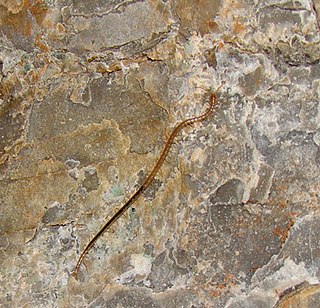
Lithobius is a large genus of centipedes in the family Lithobiidae, commonly called stone centipedes, common centipedes or brown centipedes.

Cormocephalus is a genus of centipedes of the family Scolopendridae, containing the following species:

Polydesmida is the largest order of millipedes, with more than 5,000 species, including all the millipedes reported to produce hydrogen cyanide (HCN). This order is also the most diverse of the millipede orders in terms of morphology. Millipedes in this order are found in all regions of the world other than Antarctica.

Myriapodology is the scientific study of myriapods which includes centipedes and millipedes. The field of myriapodology can also cover other myriapods such as pauropods and symphylans. Those who study myriapods are myriapodologists.

Xystodesmidae is a family of millipedes in the suborder Leptodesmidea within the order Polydesmida. The family Xystodesmidae was created by the American biologist Orator F. Cook in 1895 and named after the genus Xystodesmus. This family includes more than 390 known species distributed among 62 genera. Many species, however, remain undescribed: for example, it is estimated that the genus Nannaria contains over 200 species, but only 25 were described as of 2006. By 2022, 78 species in Nannaria have been described.

Julidae is a family of millipedes in the order Julida, containing more than 600 species in around 20 genera. Its members are largely confined to the Western Palaearctic, with only a few species extending into the Oriental and Afrotropical realms. They are united by a characteristic form of the mouthparts, and are classified in the superfamily Juloidea of the order Julida, alongside the families Trichoblaniulidae, Rhopaloiulidae and Trichonemasomatidae.

Blaniulus is a genus of millipedes containing the following species:

Henry Wilfred Brolemann was a French myriapodologist and former president of the Société entomologique de France known for major works on centipedes and millipedes, of which he named some 500 species. Brolemann was born on 10 July 1860 in Paris, to a wealthy family of Israelite industrialists and bankers that had long since converted to Protestantism. He graduated from the University of Paris and was in the banking business early in life, then left for studies in the United States, including at Indiana University, and then studied in Italy before returning to France and becoming one of the world's experts in myriapods. Brolemann was fluent in English, German and Italian, and wrote in Spanish and Portuguese.

Trachysphaera is a genus of dwarf pill millipedes in the order Glomerida. Just over 30 species are known, making it the third most species-rich genus of Glomerida. Trachysphaera species are patchily distributed throughout Europe and western Asia, extending from Spain to Caucasia. Members of this genus are tiny, with modified appearances resembling that of calcareous stones.

Geophilus is a large, heterogeneous genus of soil centipedes in the family Geophilidae largely considered to be synonymous with Brachygeophilus. The generic name first appeared in Brewster's Edinburgh Encyclopaedia in 1814 as Geophilus electricus. This genus has a Holarctic distribution.

Craspedosomatidae is a family of millipedes in the order Chordeumatida. Most adult millipedes in this family have 30 segments, but some have only 28. There are at least 30 genera and 210 described species in Craspedosomatidae.

Trigoniulus is a genus of millipede in the family Trigoniulidae. There are at least 90 described species in Trigoniulus.

Iulomorphidae is a family of millipedes in the order Spirostreptida. There are about 11 genera and more than 60 described species in Iulomorphidae.
Geoglomeris subterranea is a species of myriapod belonging to the family Glomeridae.
Australiosoma is a genus of millipedes belonging to the family Paradoxosomatidae.

Cryptops sometimes known as cave centipedes, is a centipede genus in the family Cryptopidae; species records have a world-wide distribution.

Otostigmus is a genus of centipedes in the family Scolopendridae. It was first described by Swedish naturalist Carl Oscar von Porat in 1876. The genus as a whole comprises around 157 species, found primarily in the Neotropics.

Ribautia is a genus of centipedes in the family Geophilidae. This genus was described by French myriapodologist Henry Wilfred Brolemann in 1909. Centipedes in this genus are found in South America, tropical Africa, Madagascar, the Arabian peninsula, Australia, New Zealand, and Melanesia.
Schendyla is a genus of soil centipedes in the family Schendylidae. These centipedes are found in the west Palearctic region. This genus was described by Danish entomologists Vilhelm Bergsøe and Frederik Vilhelm August Meinert in 1866. This genus now includes more than 20 species.
Devillea is a genus of flat-backed millipedes in the family Xystodesmidae. These millipedes are rare and limited to caves. Species in this genus are found in Sardinia, Capri, and southern France in the Maritime Alps. These species are notable for featuring more than the 20 segments usually found in the order Polydesmida. This genus is one of only two genera in this order to feature these extra segments and the first such genus to be discovered.














